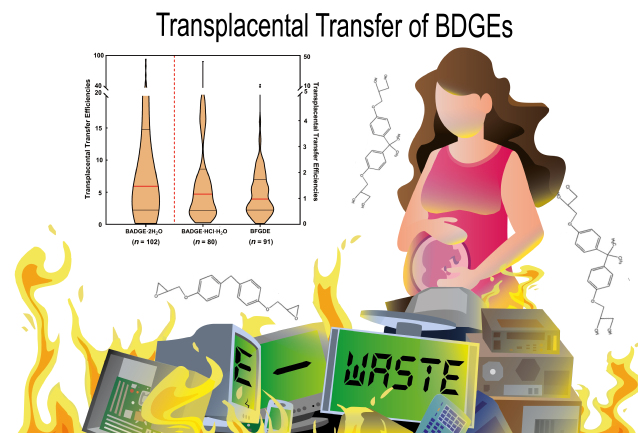
Highlights
BFDGE and two derivatives of BADGE were frequently detected in paired maternal serum and cord serum samples for the first time.
The observed high trans-placental potentials of BADGE·2H2O and BADGE·HCl·H2O suggest their high accumulation in fetuses.
Significant associations between BDGEs in maternal serum and maternal clinical indicators indicated the potential influence on introducing liver injury.
Abstract: Despite high production and usage, little is known about exposure to bisphenol diglycidyl ethers (BDGEs) and their derivatives in pregnant women and fetuses. In this study, we determined nine BDGEs in 106 paired maternal and cord serum samples collected from e-waste dismantling sites in South China. Bisphenol A bis (2,3-dihydroxypropyl) glycidyl ether (BADGE·2H2O), bisphenol A (3-chloro-2-hydroxypropyl) (2,3-dihydroxypropyl) glycidyl ether (BADGE·HCl·H2O), and bisphenol F diglycidyl ether (BFDGE) were the major BDGEs, with median concentrations of 0.57, 4.07, and 1.60 ng/mL, respectively, in maternal serum, and of 3.58, 5.61, and 0.61 ng/mL, respectively, in cord serum. The trans-placental transfer efficiencies (TTEs) were estimated for BDGEs found in samples, and median values were in the range of 0.98 (BFDGE) to 5.91 (BADGE·2H2O). Our results suggested that passive diffusion plays a role in the placental transfer of BADGE·HCl·H2O and BFDGE, whereas several mechanisms contribute to the high accumulation of BADGE·2H2O in cord serum. Multiple linear regression analysis indicated significant associations between maternal serum concentrations of BDGEs and blood clinical biomarkers, especially those related to liver injury, such as alanine aminotransferase (ALT), aspartate aminotransferase (AST), alkaline phosphatase (ALP), and adenosine deaminase (ADA) (P < 0.05). To our knowledge, this is the first study to report the occurrence of BDGEs in paired maternal-fetal serum samples and provide new insights into prenatal and fetal exposures. The newly discovered TTEs in maternal-fetal pairs contribute to a fuller inventory of the transmission activity of pollutants in the human body, ultimately adding to a more significant comprehensive risk evaluation.
Keywords: Bisphenol diglycidyl ethers; Maternal-fetal pairs; Transplacental transfer; Exposure
DOI: 10.1016/j.eehl.2022.11.004